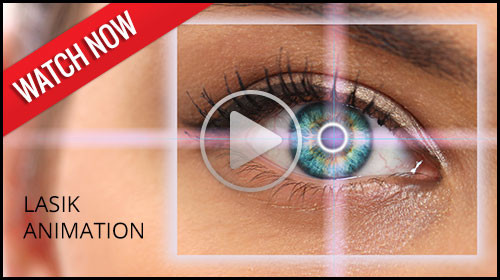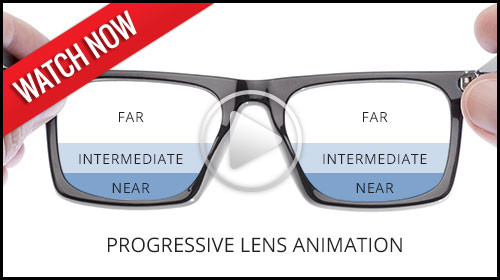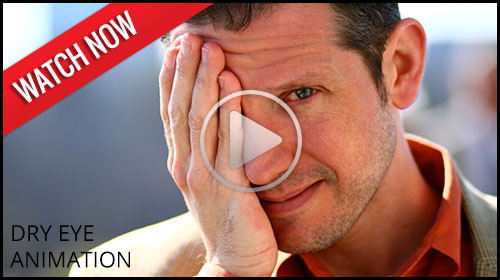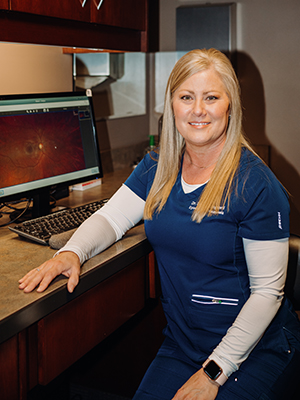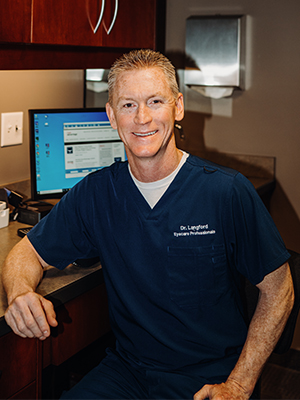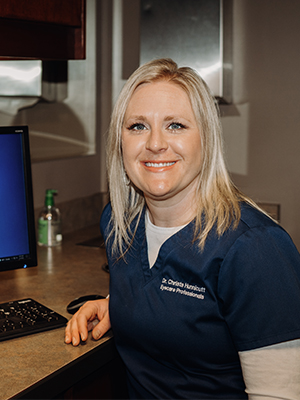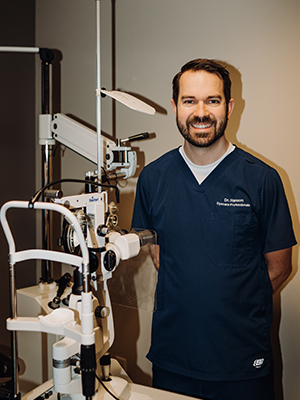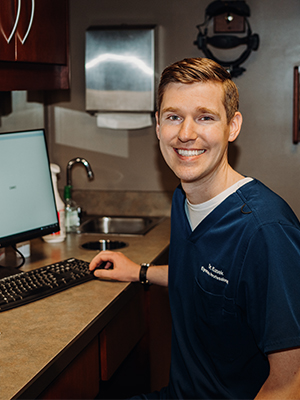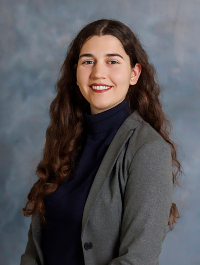Children's Vision
Children with uncorrected vision conditions or eye health problems face many barriers in life, academically, socially, and athletically. High-quality eye care can break down these barriers and help enable your children to reach their highest potential. As a parent, make sure you are giving your children the eye care they need. Presented are guidelines from the American Optometric Association.
Infant Vision

Your baby has a whole lifetime to see and learn. But did you know your baby also has to learn to see? As a parent, there are many things that you can do to help your baby’s vision develop.
When your baby is about six months, you should take him to your doctor of optometry for his first thorough eye examination. Things that the optometrist will test for include excessive or unequal amounts of nearsightedness, farsightedness, astigmatism, lack of eye movement ability, as well as other eye health problems. These problems are not common, but it is important to identify children who have them at this stage. Vision development and eye health problems can be more easily corrected if treatment is begun early.
Unless you notice a need or your doctor of optometry advises you otherwise, your child’s next eye exam should be around age three, and then again before he or she enters school.
During the first four months of life, your baby should begin to follow moving objects with the eyes and to reach for things, first by chance and later more accurately, as hand-eye coordination and depth perception begin to develop.
To help, use a nightlight or other dim lamp in your baby’s room; change the crib’s position frequently and your child’s position in it; keep reach-and-touch toys within your baby’s focus, about eight to twelve inches from his eyes; talk to your baby as you walk around the room; alternate right and left sides with each feeding, and hang a mobile above and outside the crib.
Between four and eight months, your baby should begin to turn from side to side and use her arms and legs. Eye movement and eye/body coordination skills should develop further and both eyes should focus equally.
Enable your baby to explore different shapes and textures with his or her fingers; give your baby the freedom to crawl and explore; hang objects across the crib, and play “patty cake” and “peek-a-boo” with your baby.
From eight to twelve months, your baby should become mobile, crawling and pulling himself or herself up. He or she will begin to use both eyes together to judge distances and grasp and throw objects with greater precision. To support development do not encourage early walking – crawling is important in developing eye-hand-foot-body coordination; give your baby stacking and take-apart toys; and provide objects your baby can touch, hold and see at the same time.
From one to two years, your child’s eye-hand coordination and depth perception will continue to develop and he or she will begin to understand abstract terms. Things you can do are to encourage walking; to provide building blocks, simple puzzles, and balls; and to provide opportunities to climb and explore indoors and out.
There are many other affectionate and loving ways in which you can aid your baby’s vision development. Use your creativity and imagination. Ask your doctor of optometry to suggest other specific activities.
Pre-School Vision

During the infant and toddler years, your child has been developing many vision skills and has been learning how to see. In the preschool years, this process continues as your child develops visually guided eye-hand-body coordination, fine motor skills, and the visual motor skills necessary to learn to read.
As a parent, you should watch for signs that may indicate a vision development problem, including a short attention span for the child’s age; difficulty with eye-hand-body coordination in ball play and bike riding; avoidance of coloring and puzzles and other detailed activities.
There are everyday things that you can do at home to help your preschooler’s vision develop as it should.
These activities include reading aloud to your child and letting him or her see what you are reading; providing a chalkboard, finger paints and different shaped blocks and showing your child how to use them in imaginative play; providing safe opportunities to use playground equipment such as a jungle gym and balance beam; and allowing time for interacting with other children and for playing independently.
By age three, your child should have a thorough optometric eye examination to make sure your preschooler’s vision is developing properly and there is no evidence of eye disease. If needed, your doctor can prescribe treatment including glasses and/or vision therapy to correct a vision development problem.
Here are several tips to make your child’s optometric examination a positive experience:
- Make an appointment early in the day. Allow about one hour.
- Talk about the examination in advance and encourage your child’s questions.
- Explain the examination in your child’s terms, comparing the E chart to a puzzle and the instruments to tiny flashlights and a kaleidoscope.
Unless recommended otherwise, your child’s next eye examination should be at age five. By comparing test results of the two examinations, your optometrist can tell how well your child’s vision is developing for the next major step. . .the school years.
School-Age Vision

A good education for your child means good schools, good teachers, and good vision. Your child’s eyes are constantly in use in the classroom and at play. So when his or her vision is not functioning properly, learning and participation in recreational activities will suffer.
The basic vision skills needed for school use are:
- Near Vision. The ability to see clearly and comfortably at 10-13 inches.
- Distance Vision. The ability to see clearly and comfortably beyond arm’s reach.
- Binocular coordination. The ability to use both eyes together.
- Eye movement skills. The ability to aim the eyes accurately, move them smoothly across a page and shift them quickly and accurately from one object to another.
- Focusing skills. The ability to keep both eyes accurately focused at the proper distance to see clearly and the ability to change focus quickly.
- Peripheral awareness. The ability to be aware of things located to the side while looking straight ahead.
- Eye/hand coordination. The ability to use the eyes and hands together.
If any vision skills are lacking, your child will have to work harder. This can lead to headaches, fatigue, and other eyestrain problems. As a parent, be alert for symptoms that may indicate your child has a vision or visual processing problem. Be sure to tell your optometrist if your child frequently:
- Loses his place while reading.
- Avoids close work.
- Holds reading material closer than normal.
- Tends to rub his eyes.
- Has headaches.
- Turns or tilts head to use one eye only.
- Makes frequent reversals when reading or writing.
- Uses fingers to maintain place when reading.
- Omits or confuses small words when reading.
- Consistently performs below potential.
Since vision changes can occur without you or your child noticing them, your child should visit the optometrist at least every two years, or more frequently if specific problems or risk factors exist. If needed, the doctor can prescribe treatment including eyeglasses, contact lenses, or vision therapy.
Remember, a school vision or pediatrician’s screening is not a substitute for a thorough eye examination.
Protective Eyewear
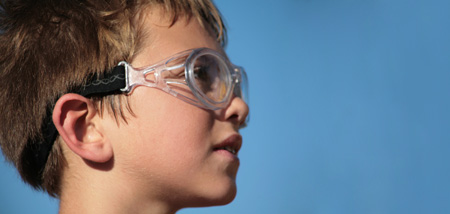
Never overlook the importance of safety eyewear when playing sports. Every year, hundreds of men, women, and children are injured while playing sports. To help prevent sports-related eye injuries, athletes should use protective athletic eyewear whether or not prescription eyewear is needed. One choice is a sports frame with prescription or non-prescription polycarbonate lenses. Baseball or softball players who are hit in or near the eye, or suffer a blow to the head, should seek immediate care at a hospital emergency room or from an eye care professional.
Children and Contact Lenses
The important thing to remember for parents of children who wear contact lenses is that contacts are prescribed medical devices. Contact lenses are not a cosmetic accessory. While the wearer may be happy about his or her new look, it is extremely important that the lenses be properly cleaned and worn according to the instructions of the optometrist.
5 things to know about Children's Vision
- How important is early detection in children's vision?
Answer: Early intervention is the key to success .
80% of learning comes through vision.
By at least age 3 or 4, the child needs a comprehensive eye exam. And even 6 months old is not too early.
They won't outgrow a " lazy eye" or undetected eye problem. - Isn't a school vision screening or Pediatrician screening good enough?
Answer: No.
Although school screenings, nurses, and pediatricians are extremely valuable, they don't take the place of a comprehensive eye exam by an Optometrist or Ophthalmologist .
In fact, school screenings can give a false sense of security. There are visual skills necessary for reading beyond just reading an eye chart. If kids frequently lose their place while reading , they may benefit from glasses or vision exercises or therapy .
Vision Therapy is training of the eyes that help problems glasses alone do not. - What are symptoms of children's eye problems?
Answer:
Decreased performance in school
Aversion to reading
Excessive blinking
Rubbing eyes
Headaches
Can't see 3-D movies
Also, remember Pediatricians recommend only 2 hours of screen time per day . Screen time includes : Television,Computer, computer games, video games , hand held video games, and IPads. - What are some serious disorders of the eye you look for in an exam?
Answer:
Most common are severe nearsightedness( myopia) , astigmatism ,or farsightedness ( hyperopia) that can be corrected with glasses.
More serious conditions may need surgery or vision therapy such as Esotropia , where the eye turns in, or Exotropia where the eye turns out.
Amblyopia(or lazy eye) affects 3 to 5% of the population it is where the brain does not use one eye and it can only be detected through an eye examination.If not caught or treated by age 8, the child can be left with permanent visual impairment.
Children typically will NOT outgrow these conditions ,they need treatment.
A more rare but life threatening condition is a fast growing eye tumor called retinoblastoma . It is life threatening because the proximity of the eye is so close to the brain that fast intervention is critical. This is a condition that parents might notice by looking at pictures of the eyes and noticing a "white pupil."
The eye needs to be dilated in order to detect this condition.
Lastly, Shaken Baby Syndrome is a social issue that is on the rise, and it causes brain and retinal hemorrhage, as well as detachment and death. Although it is NEVER ok to shake ANY child, but particularly Children up to age 3 do not have strong enough neck muscles to protect the vital organs from damage.
It is fine to bounce a baby on your knee in a playful manner, but Shaken Baby Syndrome happens when a forceful angry shaking occurs by an adult. - Where do I go for good information on Children's vision?
Answer:
Ask your local eye care provider personal questions.
Websites:
AOA.org. AMERICAN Optometric Association Look for InfantSEE program
Infantsee.org
It is a no cost public health program for early detection in the first year of life
dontshake.org. National center on Shaken Baby Syndrome
AAP.org(American Academy of Pediatrics)


